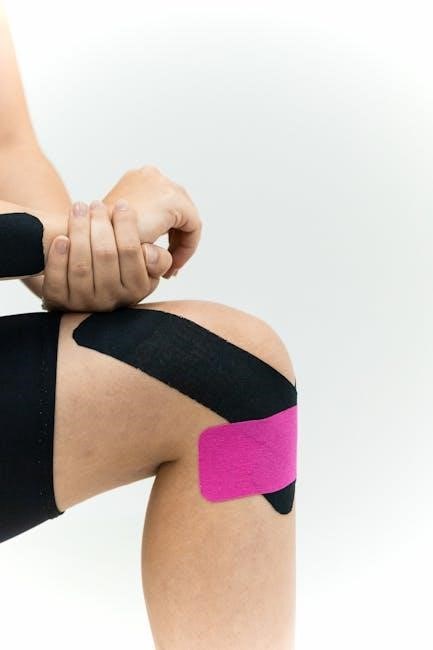Therapy band exercises are portable and inexpensive, using resistance bands for strength training, with various exercises available, including upper and lower extremity exercises, for overall body fitness and health benefits always.
Benefits of Therapy Band Exercises
Therapy band exercises offer numerous benefits, including increased strength and flexibility, improved range of motion, and enhanced overall fitness. They are also low-cost and portable, making them easily accessible for use at home or while traveling. Additionally, therapy band exercises can be modified to suit different fitness levels, allowing individuals to progress at their own pace. The use of resistance bands also reduces the risk of injury, as they provide a gentle and controlled form of resistance. Overall, therapy band exercises are a convenient and effective way to improve physical health and well-being, and can be incorporated into a variety of fitness routines. They are also a great option for individuals who prefer a low-impact form of exercise, or for those who are recovering from injury or surgery, and can be used in conjunction with other forms of exercise.
Types of Therapy Bands
There are various types of therapy bands available, each with its own unique characteristics and benefits. Some therapy bands are made of latex, while others are made of synthetic materials. They also come in different colors, which often indicate the level of resistance provided. Additionally, therapy bands can be found in various lengths and widths, allowing individuals to choose the one that best suits their needs. Some therapy bands are also designed for specific purposes, such as yoga or Pilates, and may have textured surfaces or grips to enhance performance. Overall, the variety of therapy bands available allows individuals to select the one that best meets their fitness goals and preferences, and to incorporate them into their exercise routine in a way that is both challenging and enjoyable. They are also easy to clean and maintain, making them a practical choice.

Getting Started with Therapy Band Exercises
Begin with simple exercises and gradually increase difficulty, using proper technique and form, to achieve desired fitness goals and health benefits always with therapy bands.
Choosing the Right Resistance Level
To choose the right resistance level, consider your fitness goals and current level of strength, as well as any physical limitations or injuries you may have.
It is essential to select a resistance level that challenges you but is not so difficult that it causes discomfort or pain.
Using a resistance level that is too easy will not provide an effective workout, while a level that is too hard can lead to injury.
You can start with a lower resistance level and gradually increase it as you become stronger.
It is also important to consult with a therapist or healthcare professional to determine the best resistance level for your specific needs and abilities.
By choosing the right resistance level, you can get the most out of your therapy band exercises and achieve your fitness goals.
This will help you to stay motivated and engaged in your exercise routine.
Proper Technique and Form
Proper technique and form are crucial when performing therapy band exercises to ensure safety and effectiveness.
It is essential to maintain good posture and engage your core muscles to support your movements.
You should also focus on slow and controlled movements, avoiding jerky or bouncy actions that can put unnecessary strain on your muscles and joints.
Additionally, it is important to keep the resistance band at a comfortable tension, neither too tight nor too loose, to allow for smooth and consistent movements.
By using proper technique and form, you can maximize the benefits of your therapy band exercises and minimize the risk of injury or discomfort.
Using proper technique will also help you to target the specific muscle groups you want to work on, leading to more effective and efficient workouts.
This will help you to achieve your fitness goals and improve your overall health and well-being.

Upper Extremity Therapy Band Exercises
Exercises target shoulders, arms, and chest, improving overall upper body strength and flexibility always using resistance bands.
Chest Pull Exercise
The chest pull exercise is a common therapy band exercise that targets the chest muscles, improving strength and flexibility. To perform this exercise, loop the therapy band around each palm and pull the band apart, stretching the chest muscles. This exercise can be done while sitting or standing, with feet shoulder-width apart. The therapy band should be held at shoulder level, with palms facing down. As the band is pulled apart, the chest muscles are engaged, providing a gentle stretch. This exercise is often used in physical therapy to improve upper body strength and mobility. The chest pull exercise is a simple yet effective way to target the chest muscles, and can be modified to suit different fitness levels. By incorporating this exercise into a regular routine, individuals can improve their overall upper body strength and flexibility; Regular practice is recommended for optimal results.
Shoulder Rotation Exercise
The shoulder rotation exercise is a therapy band exercise that targets the shoulder muscles, improving flexibility and range of motion. To perform this exercise, hold the therapy band in one hand and attach the other end to a stable object. Hold the band at shoulder level and rotate the shoulder in a circular motion, first clockwise and then counterclockwise. This exercise can be done while standing or sitting, with the arm at shoulder level. The therapy band provides gentle resistance, helping to strengthen the shoulder muscles. Regular practice of this exercise can help improve shoulder mobility and reduce stiffness. It is essential to start with slow and controlled movements, gradually increasing the speed and range of motion as the shoulder becomes more flexible. By incorporating this exercise into a regular routine, individuals can improve their overall shoulder health and function. Proper technique is crucial for effective results.

Lower Extremity Therapy Band Exercises
Therapy band exercises target legs and ankles, improving strength and flexibility, using resistance bands for effective and portable workouts always and everywhere easily.
Ankle Exercise
Ankle exercises using therapy bands are essential for improving ankle strength and flexibility, and can be performed while sitting or standing, with the band looped around the ankle and attached to a stable object, allowing for a range of motion exercises to be performed, such as ankle rotations and flexions, which can help to improve balance and reduce the risk of injury, and can be modified to suit different fitness levels, making them accessible to a wide range of individuals, and can be incorporated into a comprehensive exercise program to promote overall lower extremity health and wellness, and can be used in conjunction with other exercises to achieve optimal results, and can be adjusted to increase or decrease resistance as needed.
Knee Extension Exercise
The knee extension exercise using therapy bands is a effective way to strengthen the quadriceps muscles, and can be performed while sitting or standing, with the band looped around the ankle and attached to a stable object, allowing for a range of motion exercises to be performed, such as straightening the knee against the resistance of the band, which can help to improve knee function and reduce the risk of injury, and can be modified to suit different fitness levels, making them accessible to a wide range of individuals, and can be incorporated into a comprehensive exercise program to promote overall lower extremity health and wellness, and can be used to target specific muscle groups, such as the quadriceps and hamstrings, to achieve optimal results and improve overall knee health, with regular practice and progression of exercises.

Precautions and Safety Guidelines
Exercisers should consult therapists and inspect bands for damage before use always and follow guidelines carefully to avoid injury.
Avoiding Injury and Discomfort
To avoid injury and discomfort, it is essential to follow proper guidelines and precautions when performing therapy band exercises. This includes inspecting the resistance bands for damage before use and consulting with a therapist for specific instructions. Additionally, exercisers should be aware of their body position and movement to avoid putting unnecessary strain on their muscles and joints. It is also crucial to start with low resistance levels and gradually increase the intensity as the body adapts to the exercises. By taking these precautions, individuals can minimize the risk of injury and discomfort, and maximize the benefits of therapy band exercises. Proper technique and form are also vital in avoiding injury, and exercisers should prioritize these aspects when performing the exercises. Regular monitoring of the body’s response to the exercises can also help identify potential issues early on.
